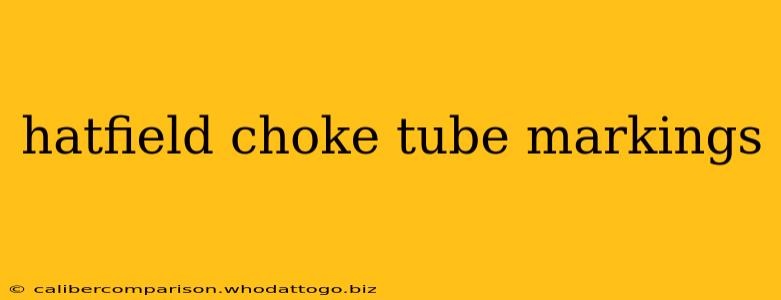Understanding your shotgun choke tubes is crucial for achieving consistent patterns and optimal performance on the field or range. This guide focuses specifically on deciphering the markings found on Hatfield choke tubes, providing you with the knowledge to select the right choke for your hunting or shooting needs. Hatfield, known for its quality and precision, uses a clear, yet often overlooked, marking system. Let's break down what those markings mean.
Understanding the Basics of Choke Tubes
Before diving into Hatfield-specific markings, let's briefly review the fundamental purpose of choke tubes. Choke tubes constrict the diameter of the barrel at the muzzle, influencing the shot pattern. A tighter choke (like Full) creates a tighter pattern at longer ranges, ideal for waterfowl hunting. A more open choke (like Improved Cylinder) produces a wider pattern, better suited for closer-range shooting like upland bird hunting.
Common Hatfield Choke Tube Markings and Their Meanings
Hatfield choke tubes typically use a combination of text and sometimes color-coding to denote the constriction. While exact markings may vary slightly depending on the model and age of the choke tube, you'll generally find one of the following:
Text-Based Markings:
- Cylinder: This is the most open choke, offering the widest pattern and shortest effective range. The marking might simply be "CYL".
- Improved Cylinder (IC): Slightly tighter than Cylinder, providing a balance between pattern density and range. Marked as "IC".
- Modified (M): A versatile choke, offering a good compromise between pattern density and range, suitable for a variety of game. Marked as "M".
- Improved Modified (IM): Tighter than Modified, providing denser patterns at longer ranges. Marked as "IM".
- Full (F): The tightest choke, offering the densest pattern and longest effective range, ideal for long-range shots at waterfowl. Marked as "F".
- Extra Full (XF or sometimes marked as "Turkey"): Even tighter than Full, optimized for extremely long-range shots or turkey hunting. Look for "XF" or "Turkey".
Color-Coding (If Applicable):
Some Hatfield choke tube sets might use color-coding to assist in quick identification. However, this isn't a standard across all their products. Always refer to the accompanying documentation or the Hatfield website for specific color-coding schemes if present.
Identifying Your Hatfield Choke Tube: A Step-by-Step Guide
- Carefully examine the choke tube: Look for any markings stamped or etched onto the tube itself. These markings are usually located near the base or shoulder of the tube.
- Identify the text: Compare the text on your choke tube to the common markings listed above.
- Check for color-coding (if applicable): If you see a color band or marking, consult the Hatfield documentation to understand its meaning.
- Consult the Hatfield website or contact their customer service: If you still have trouble identifying your choke tube, use their online resources or contact them directly; they can help you decode the markings and determine the correct constriction for your specific choke tube.
Choosing the Right Choke for Your Shooting Situation
Understanding your Hatfield choke tube markings is just the first step. The right choke tube depends on the type of game you're hunting, the distance to your target, and the size of shot you're using. Experimentation and practice are key to finding the optimal choke for your specific needs.
By understanding these markings, you can confidently select and utilize your Hatfield choke tubes to maximize your shooting performance and ensure a successful hunting or shooting experience. Remember to always practice safe gun handling techniques.

